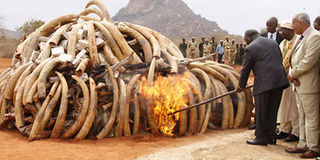Africa sends fiery warning to poachers

Photo/LABAN WALLOGA
President Mwai Kibaki sets ablaze an illegal ivory stockpile on July 20, 2011 at the Tsavo National Park.
Africa sent a strong message to poachers of its elephants by setting ablaze nearly five tonnes of contraband ivory worth millions of shillings on Wednesday.
President Kibaki led representatives of regional governments in lighting the ivory pier at the Kenya Wildlife Service Training School in Manyani in Taita Taveta county.
“Through the burning of this contraband ivory, we are sending a clear message to poachers and illegal traders in wildlife about our collective resolve to fight this crime in our region and beyond,’’ the President said before lighting the fire.
Poachers and illegal traders in ivory, he added, must know that their days were numbered and severe punishment would be meted to those engaging in the decimation of wildlife.
“We cannot afford to sit back and allow criminal networks destroy our common future,” he added.
The large crowd that turned up to witness the rare event cheered as the President lit the ivory shortly after 2pm.
The tusks, which made a seven-foot pier were piled on a fire grid bar built by Dynamic Green Technologies.
It was doused with kerosene, donated by Total Kenya, and pumped from several gallons situated 500 metres away.
But even as the world witnessed yet another burning of the tusks captured from poachers and dealers across the globe, wildlife conservationists demanded tougher laws to stamp out the illicit trade.
They cited light sentences handed to poachers and dealers in game trophy as the main reason the illicit trade continued to thrive.
This is the third time an ivory stockpile is being destroyed in Africa. Retired president Daniel arap Moi first lit fire to an ivory stockpile in 1989 at the Nairobi National Park. The Zambian government burned another pile in 1992.
The event was the highlight of the first ever African Elephant Law Enforcement Day celebrations observed by Kenya and seven African states that have come together under the Lusaka Agreement on Cooperation Enforcement Operation Directed at Illegal Trade in Wild Fauna and Flora.
The consignment comprised 335 solid elephant tusks and 41,553 ivory hankos or processed ivory.
They were seized by the Singapore customs authorities in June 2002 and subsequently brought to Kenya by the Lusaka Agreement Task Force in March 2004 for investigations.
The investigations determined its probable origins as Malawi, Tanzania and Zambia.
Experts who spoke to the Nation said a kilogramme of elephant tusks fetches between Sh13,000 and Sh16,000 on the black market.
This places the value of the 4.9 tonnes at between Sh63 million and Sh78 million.
Kenya Wildlife Service director Julius Kipng’etich spoke of massive devastation that poaching had handed elephant populations in a number of African countries.
Nigeria and Liberia, he said, had virtually lost all their elephants while Senegal remained with only eight.
The 1989 burning of ivory by Mr Moi helped Kenyan check the slaughter of its elephants.
In 1989, the population of the elephants in Kenya had dropped from 167,000 in the 1970s to a mere 16,000.
However, Kenya managed to reverse the slide and now has 37,000 elephants.
Ms Soila Sayialel, an elephant conservationist at Amboseli National Park, said time had come for the government to move from the routine burning to enactment of tough laws.
“Governments can burn ivory to create awareness but unless we have tough laws, the danger remains,” said Ms Sayialel.
Such laws should focus on neutralising the high demand for ivory across the continent and globally.
Her sentiments were echoed by Wild Wide Fund for Nature (WWF) which called on countries to strengthen law enforcement and clean-up domestic ivory markets.




